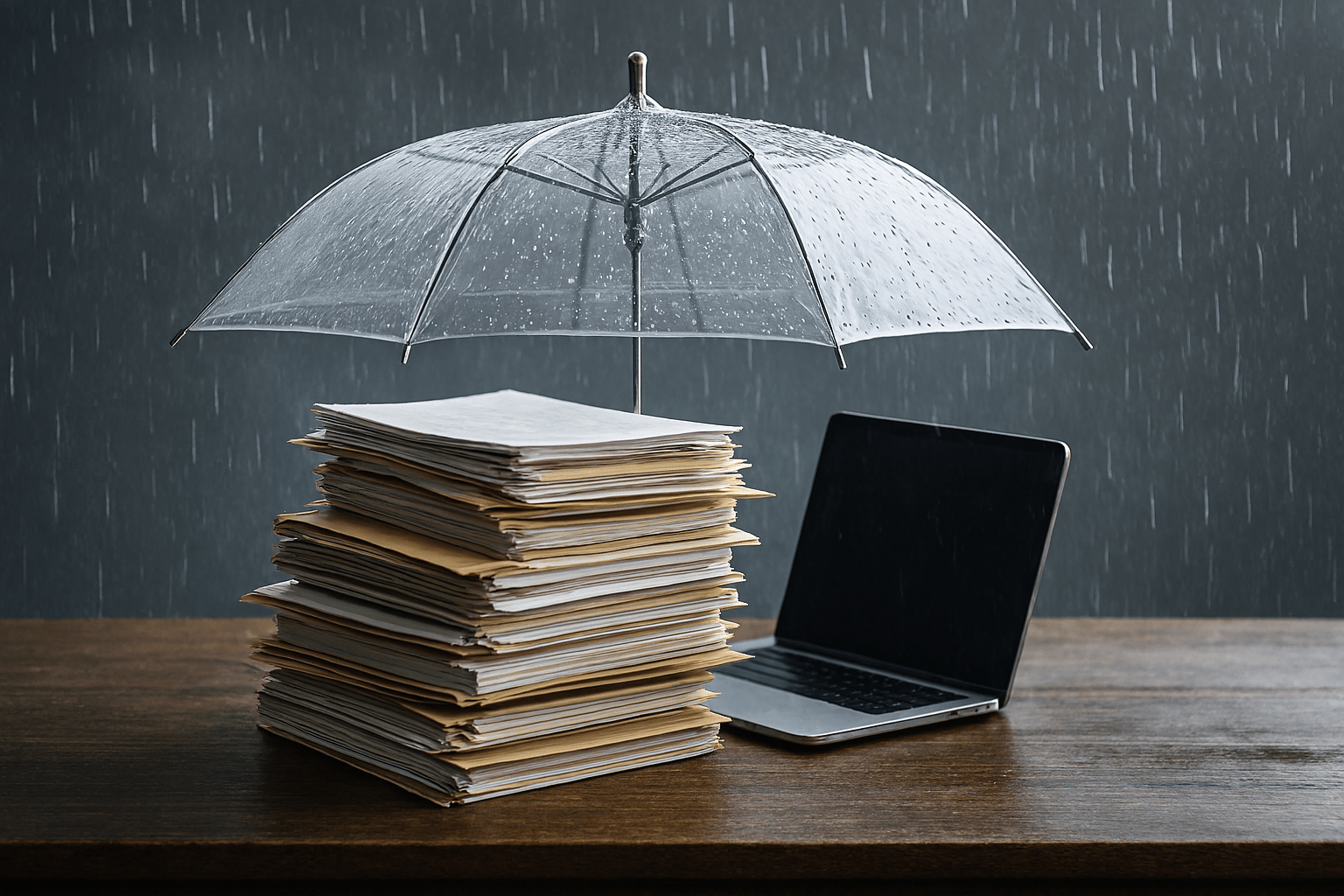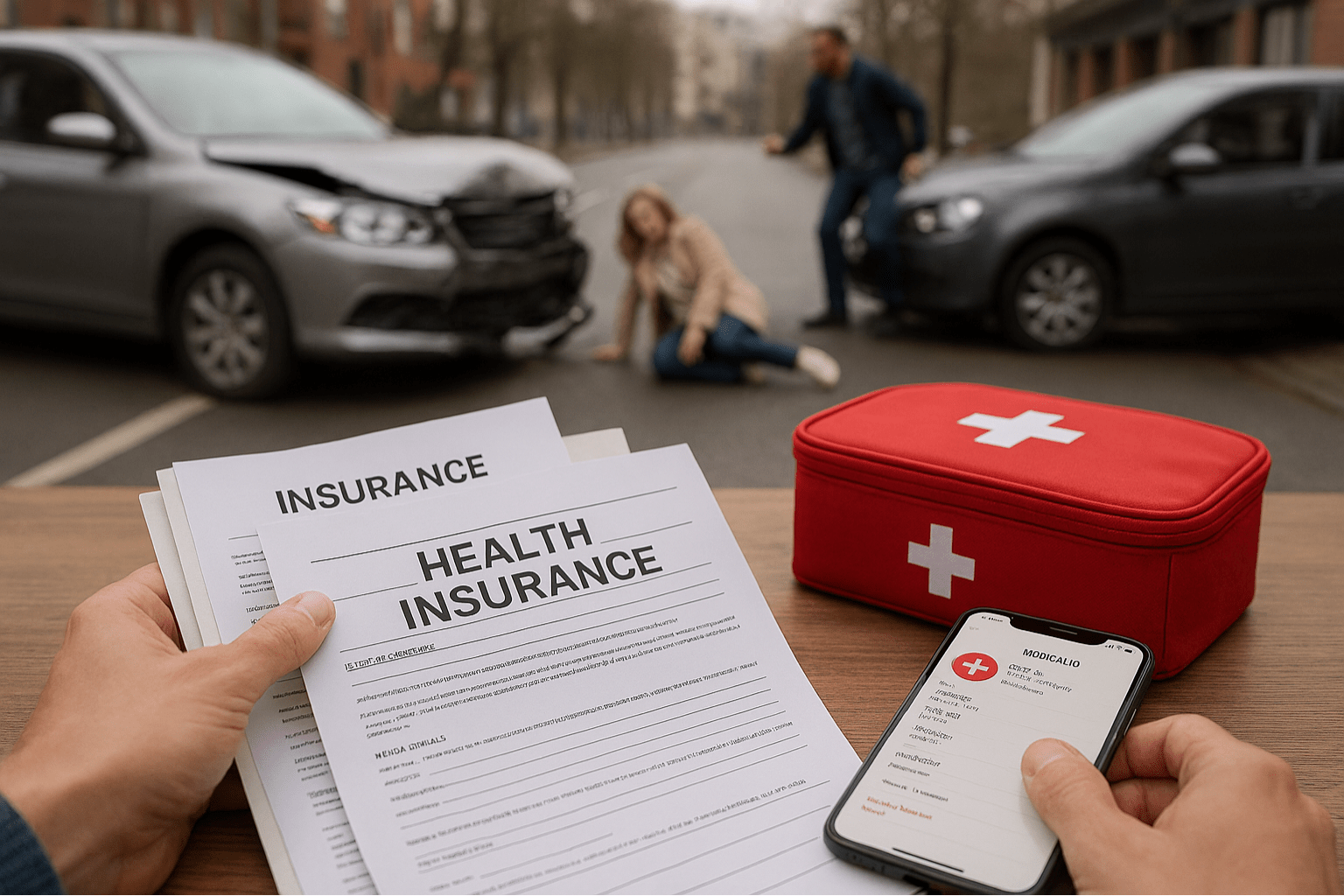Category: Safety & Security
What Happens If You Don’t Keep Your Insurance Info Updated?
November 19, 2025

Most of us buy insurance with good intentions. We sign the papers, file them away, and honestly, we don’t think much about them again. Life gets busy. Updating insurance info is the kind of task that quietly slips off the radar. But here’s the thing: life changes constantly, and your insurance doesn’t magically keep up.
If your policy stays the same while everything else in your life shifts around, you might end up with coverage that doesn’t match your situation anymore. And that usually shows up at the worst possible time.
Why Keeping Info Updated Actually Matters
Insurance companies depend on accurate details. They decide coverage and pricing based on the information you gave them at the start. If something meaningful changes and you don’t tell them, the policy may not reflect reality anymore.
Think about how often little changes happen: moving to a different place, adding someone new to the family, buying things you’d be upset to lose, fixing up your house, or even having changes at work. None of these moments seem “insurance-worthy” at the time, but they actually matter.
What Could Happen If Nothing Gets Updated
A lot of people assume that as long as premiums are paid, everything is fine. Unfortunately, insurance doesn’t exactly work that way.
1. Claims Might Not Go Smoothly
If something goes wrong and you file a claim, the insurer will check whether your information matches your real situation. If they find a big difference, the claim might get delayed, reduced, or rejected. For example, if your home is worth more because of renovations and you didn’t update the policy, the payout probably won’t cover the full damage.
2. You Might Not Have Enough Coverage
People often don’t realize their coverage is outdated until something happens. Maybe your family has grown, or you’ve bought more valuable items. A policy that once fit perfectly might not come close now.
3. The Policy Could Be Cancelled
Insurance companies expect major details to be accurate. If something important wasn’t updated, they can cancel the policy. In rare cases, they may even say it was never valid.
4. Renewal Might Become Expensive
Sometimes outdated details cause confusion during reviews. Even if the claim goes through, renewal might come with a higher price tag.
5. Stress Piles Up When You Least Want It
Insurance is supposed to offer relief during stressful times. Outdated information can turn that relief into more stress, more paperwork, more delays, and more frustration.
Things Worth Reviewing From Time to Time
It helps to check these once in a while:
- Where you live
- Changes in your family
- Any expensive new purchases
- Home improvements or upgrades
- Vehicle changes or new drivers
- Major health or job changes
- Beneficiaries
A simple yearly check is enough for most people.
Easy Ways to Keep Everything Updated
You don’t need to make this complicated. A few easy habits can help:
- Glance over your policies once a year.
- Whenever something big happens, just send a quick update.
- Keep all your insurance documents in one place so you don’t forget what you have.
- Make a short list of things that typically change over time.
- Ask the insurer when you’re unsure; they’re used to these questions.
Final Thoughts
Insurance is meant to support you when life gets tough, but it can only do that if the information behind the policy reflects your current situation. When details sit unchanged for too long, the coverage weakens and sometimes disappears when you need it most.
A few minutes of updating here and there can save you from a lot of trouble later. It doesn’t take much, but it makes a big difference when life throws something unexpected your way.
Moving Into a New Home? Important Documents to Update and Store
November 12, 2025

The day you move into a new home is always a blur. There are boxes everywhere, someone’s hunting for the screwdriver, and the Wi-Fi isn’t working yet. Between excitement and exhaustion, paperwork usually ends up in a pile somewhere, the “I’ll deal with it later” pile.
That pile matters more than it seems. Hidden inside are the documents that prove ownership, protect your investment, and make sure you’re covered if life throws a surprise your way. Spending even half an hour getting it sorted now can save weeks of hassle later.
Here’s an easy way to stay ahead of it all.
Step 1: Collect the Home Documents
Start with the basics: anything connected to the property itself.
The deed, the lease, closing papers, inspection reports, property taxes, the list’s not short, but every one of those pages has a job to do.
Keep them together. Snap photos or scan copies and upload them to a secure place such as InsureYouKnow.org. Paper can get lost, wet, or tossed out by mistake. A digital backup doesn’t.
Step 2: Update Every Insurance Policy
It’s easy to forget how many places your address lives: homeowners, renters, car, health, even life insurance. If you’ve moved, they all need an update.
A change of address sometimes shifts coverage or premiums. Check each policy, make sure everything looks right, and store a copy in your vault. When you actually need those papers, you won’t have to dig through drawers.
Step 3: Review Finances and Bills
Moving tends to scatter money trails. One bank has your old address, a credit card statement goes missing, and a subscription quietly keeps charging the wrong account.
Before things snowball, log in to each account, banks, credit cards, utilities, and loan providers, and double-check that your information’s current. Grab a recent statement or two and save them. Come tax season, you’ll be glad you did.
Step 4: Fix the ID and Legal Stuff
This is the least exciting part, but it matters. Out-of-date identification can make the simplest tasks harder.
Head to the DMV, update your license, change your voter registration, and check your vehicle paperwork. If you’ve moved to a different state, renew your passport details too. Take a quick photo of each ID and tuck it safely into your digital folder, one less worry if a wallet ever goes missing.
Step 5: Round Up Family and Pet Records
Families (and pets) come with paperwork of their own: school transcripts, vaccination cards, medical histories, and adoption or license documents.
Put them all in one place. Upload copies so you can reach them instantly when someone needs a school form or a vet asks for proof of shots. It’s one of those tiny habits that saves time again and again.
Step 6: Check Estate and Emergency Documents
A new home changes the big picture. If you own more now than before, or live in a different state, some legal documents might need attention.
Look at your will, trust, and power of attorney. Make sure beneficiaries are still correct and that addresses match. Upload those to your vault and share access only with the people you absolutely trust. That small act can spare family members confusion later.
Step 7: Why Digital Storage Beats a Drawer of Folders
Paper doesn’t last forever. It fades, tears, and somehow always disappears when you’re in a hurry. Digital storage, especially a secure platform like InsureYouKnow.org, keeps everything in one spot, encrypted and easy to reach from anywhere.
You can label folders, set reminders for renewals, and grant limited access to family or advisors. It turns chaos into order, quietly, efficiently, without any stress.
A Quick Reality Check
Moving is a mix of energy, emotion, and endless details. Once the boxes are gone and the house starts to feel like home, take an hour, grab that pile of paperwork, and go through it.
Scan, upload, label, done. Then forget about it for a while.
It’s not the glamorous side of homeownership, but it’s the one that keeps everything running smoothly. A little organization now means fewer surprises later, and that’s worth more than any new piece of furniture.
Seasonal Insurance Check-Up: Keep Your Coverage Up to Date
October 29, 2025

If you’ve ever opened an old folder and thought, “Wait, when did I even file this?”, you already get the point. Insurance paperwork has a way of sitting quietly until life outgrows it. People check their policies once a year, feel responsible for a minute, then forget about them. Sounds familiar, right?
Life, though, doesn’t wait. A new job pops up, someone moves, a baby arrives, or maybe there’s a home remodel that changes everything. Those small shifts can make old coverage feel out of step. By the next annual review, it’s easy to realize things don’t quite fit anymore.
Life Changes Faster Than Paperwork
Insurance is supposed to protect what matters now, not what mattered last spring. But most people never notice how fast their details drift. Maybe the car value has dropped, or a phone number changed, or the policy still lists an address that no one lives at. Tiny errors, but they matter when a claim appears.
A quick seasonal review keeps things real. It’s like glancing at your pantry before heading to the store, fast, practical, and you avoid buying what you already have.
How to Do a Seasonal Review Without Losing a Weekend
Step 1. Gather your stuff.
Pull together every policy: car, home, health, life. Keep them in one folder, digital or paper, so you’re not hunting later.
Step 2. Check the basics.
Look at names, addresses, contact numbers, and nominee info. If something looks off, fix it.
Step 3. Match it to real life.
Bought something big? Changed jobs? Maybe started freelancing? Adjust the coverage so it actually fits.
Step 4. Note payments and renewals.
Set a quick reminder on your phone. Late payments sneak up quietly.
Step 5. Keep copies safe.
A cloud folder and one printed set usually do the trick. Tell someone close where they are.
When to Check Even Sooner
Some moments don’t wait for the next season. Big life changes mean the file needs a look right away:
- Marriage or separation
- New house or sold property
- Moving cities
- Starting a business
- A new baby or dependent parent
If your life just shifted, your coverage should shift too.
Why Bother?
People who do this regularly sound calmer when things go wrong. They don’t waste time searching or wondering what’s covered. The habit keeps surprises small.
Here’s what they get out of it:
- Current coverage: Nothing outdated hiding in fine print.
- Fewer claim issues: Information is already right.
- Possible savings: You catch overlaps before paying twice.
- Less stress: Everyone knows where everything lives.
A little check four times a year adds up to peace of mind.
Make It Stick
Pick a date that already matters, your birthday month, tax season, the start of summer. Mark it as “insurance check-up” and actually do it. Once or twice and it’ll feel automatic.
The Bottom Line
Insurance only works when it keeps up with your life. A seasonal check-up isn’t overkill; it’s common sense. Fifteen minutes now can save weeks of frustration later, and that’s a trade anyone would take.
From “Promise to Pay” to “Promise to Help – The New Direction of Insurance
October 9, 2025

Insurance used to be pretty straightforward. Something went wrong, a claim was filed, and the company paid out. It was businesslike, dependable, but distant, a transaction built on the idea that help came only after things fell apart.
That mindset is slowly disappearing. Modern insurers are moving from a simple promise to pay toward something broader, a promise to help. It’s a quiet shift, but a powerful one. Instead of showing up after the storm, insurance is learning how to stand beside people before it hits.
What’s Changing and Why
A few years ago, the idea of an insurer sending out real-time alerts or helping clients avoid accidents might have sounded ambitious. Now it is becoming normal. Several forces are pushing this transformation forward.
Customer expectations have changed.
People want services that respond in the moment, not days later. They want their insurer to feel like a partner, not a policy. If their fitness app can track every heartbeat, they wonder why their insurer cannot send a simple safety reminder when a major storm is on the way.
Technology made prevention possible.
Connected homes, smart cars, and wearable tech give insurers tools to spot problems before they happen. It is no longer just about predicting who might file a claim, it is about helping them avoid needing one.
Competition sparked a rethink.
Digital-first insurers, often smaller but more agile, have proven how personal and convenient insurance can be. Established companies are learning to adapt, realizing that loyalty now comes from service, not slogans.
Trust is back in the spotlight.
In truth, insurance has always depended on trust. But trust today is earned differently, not just by paying out quickly, but by showing up early, being transparent, and actually making life a bit safer.
How the “Promise to Help” Looks in Practice
It is easy to forget that most people do not want to think about insurance at all. The “promise to help” changes that by offering useful touchpoints that matter in everyday life.
- Sending storm or flood alerts before damage happens.
- Helping drivers plan safer routes or spot maintenance issues.
- Offering healthy-living rewards that lower costs and build good habits.
- Providing quick repair or recovery options instead of endless paperwork.
- Checking in after an event, not with forms, but with guidance and reassurance.
It is still insurance, but it feels different, more human, more present.
Challenges on the Way
No big change comes without friction. Some insurers still struggle with old systems that do not talk to each other. Others are cautious about how much personal data they collect, and rightly so. Privacy is not just a legal issue, it is emotional.
There is also the challenge of tone. Helping customers without seeming intrusive takes care and empathy. A message that is meant to be helpful can easily feel like surveillance if it is poorly timed or worded.
But the companies that get this balance right are setting a new standard. They are showing that care and commerce can actually coexist.
What This Means for Policyholders
For policyholders, this new direction means fewer surprises and better peace of mind. Instead of being left on their own until something breaks, customers now get small but meaningful touches of support along the way.
They see their insurer less as a faceless institution and more as a partner in protection, a brand that does not just cover life’s troubles but helps prevent them. That sense of security, before and after a crisis, is what builds lasting trust.
How Insurers Can Keep the Promise
To make the shift sustainable, insurers will need to do more than upgrade technology. They will have to reshape how they think about service itself.
- Focus on listening. Every great service begins with understanding real needs.
- Keep technology human. Data is helpful, but empathy is irreplaceable.
- Be transparent. People should always know how and why their data is used.
- Work together. Partnerships with health, home, and repair services make help more real.
- Deliver small wins. A helpful reminder or quick response builds more loyalty than a billboard ever could.
These small, consistent actions turn a new promise into a lived experience.
A More Human Kind of Protection
The shift from a “promise to pay” to a “promise to help” is not just clever branding, it is a sign of maturity in the industry. Insurance is finding its way back to what it was meant to be: a source of reassurance in uncertain times.
When help arrives before the loss, customers notice. When it comes with understanding instead of fine print, they remember. That is how insurance stops being something people tolerate and starts becoming something they genuinely trust.
And maybe that is the kind of promise worth keeping.
What Happens to Your Digital Assets After You Die?
September 24, 2025

We spend so much of our lives online that it’s easy to forget just how much we’ve tucked away in digital spaces. Photos on Google Drive. A lifetime of emails. Bank apps, crypto wallets, even the music and books we’ve bought but never actually “own.” All of these things add up to what people now call your digital assets.
The tricky question is: what happens to them when you’re no longer here?
A Hidden Part of Your Estate
Think about how a traditional estate works. You leave a house, some savings, maybe a car, and your family knows how to claim those things. But with digital property, it is different. Passwords lock things up. Privacy laws keep companies from handing over your accounts. In many cases, providers do not even recognize heirs unless you have given explicit permission.
That means your online life, all those accounts and files, might just sit there untouched. Some platforms will eventually delete them. Others freeze them in time. And unless someone has the right access, even valuable things like cryptocurrency can disappear forever.
Why Families Struggle
It is easy to imagine the problems. Maybe your daughter knows you kept all the family photos in your Google account but cannot get past the two-factor authentication. Or perhaps you held a few thousand dollars in a crypto wallet that requires a private key only you knew. Even something as simple as canceling a subscription can be a nightmare if nobody has your login.
The result? Frustration, wasted time, and sometimes permanent loss.
The Law and the Fine Print
Adding to the confusion are the laws and service agreements. In many places, executors do not automatically get digital access. US states that follow a law called RUFADAA allow it only if you have given written consent, usually in your will. Big tech companies add another layer: Google lets you set up an Inactive Account Manager, Facebook has legacy contact settings, and Apple has its own Digital Legacy program. If you do not turn those on, your family may have no options.
So between legal barriers and tech restrictions, the default outcome is often nothing happens and accounts remain locked away.
How You Can Plan Ahead
The solution is not complicated, but it does take a little thought:
- Make a list of important accounts. It does not have to be detailed, but your family should at least know what exists.
- Decide who should handle them. Pick someone you trust and tell them they will be your digital executor.
- Write it into your will. A line or two giving that person authority can make a big difference.
- Use built-in tools. Set up legacy contacts where available. It only takes a few minutes.
- Keep access information safe. A password manager with emergency access, or a sealed note in a safe, works better than trying to share details in casual ways.
The key is to make sure someone you trust knows how to act when the time comes.
One practical way to protect your digital legacy is by using a secure service like InsureYouKnow. It allows you to store important documents, account information, and passwords in a safe, encrypted digital vault. You can control who has access and receive reminders to keep your records up to date, making it easier for your loved ones to manage your digital assets according to your wishes.
Why It Matters
Digital assets are not just about money. Sure, cryptocurrency or an online business can carry real financial weight, but the sentimental side matters just as much. Family photos, voice notes, or personal letters stored in an inbox can be treasures to those you leave behind. Without a plan, those things may vanish into the cloud forever.
By setting aside an hour or two to prepare, you can spare your loved ones unnecessary stress and give them access to the parts of your life that matter most.
Easy Cybersecurity Tips for Everyday People | InsureYouKnow
September 17, 2025

For a lot of folks, “cybersecurity” sounds like something only big companies or computer geeks deal with. But the truth? Hackers usually go after regular people because it’s easier. A weak password, one wrong click, or an ignored update can open the door to stolen money or lost files.
The good news is: basic habits can block most of it. No tech degree required.
Passwords People Actually Remember
Too many people still use “123456” or their dog’s name. One local teacher did exactly that and her email got hacked. The criminal then tried the same password on her shopping account and social media. It worked.
A better option is something odd but memorable. Instead of “Fluffy123,” think of a goofy phrase like BlueShoesDance99. Long, random, easy to remember. And honestly, password managers are a lifesaver when accounts pile up.
That Extra Lock (2FA)
Two-factor authentication might sound fancy, but it’s just a second lock. A small business owner nearly lost access to his email until 2FA blocked the hacker, who couldn’t get the code sent to his phone.
Most banks, emails, and social apps have it. Turning it on takes maybe two minutes.
Don’t Snooze Updates Forever
Almost everyone hits “remind me later” when updates pop up. A family ignored updates for months until their computer froze with malware. Repairs cost more than the laptop.
Updates may be annoying, but they fix holes criminals know about. Letting them run overnight is the easiest fix.
Those Sneaky Emails
Scam emails are slick these days. A retiree thought her bank was threatening to close her account unless she clicked a link. The logo looked perfect. Luckily, she noticed the sender’s email address was slightly off. One phone call to the real bank confirmed it was fake.
If an email feels urgent or fishy, don’t click. Go straight to the company website or call instead.
Backups Save Heartbreak
One father lost every baby photo after his hard drive failed. No backup. Nothing to recover. Since then, he keeps copies in two places: a small external drive and cloud storage. That way, if one fails, the other survives.
Phones Count Too
Phones hold more personal info than many computers. Losing an unlocked one is like handing over the keys to a stranger. A PIN or fingerprint lock is quick protection. It’s surprising how many people still skip it.
Oversharing Online
Birthdays, street names, even a child’s school—these little details show up in people’s posts every day. Hackers love that because those details often answer security questions. Keeping some things private online makes their job harder.
Quick Checks Make a Difference
A quick weekend check of accounts helps. One person caught a strange $7 charge on his debit card—it turned out to be a test run by a thief. Because he noticed early, the bank froze the card before anything bigger happened.
If Trouble Hits
If an account gets hacked, the worst thing is to freeze. Call the bank, reset passwords, and lock accounts quickly. Backups make recovery much easier. Families who’ve thought about these steps bounce back faster.
Wrapping Up
Staying safe online isn’t about being a tech expert. It’s about a handful of habits: stronger passwords, two-factor logins, letting updates run, backing things up, spotting fake emails, and not oversharing.
It’s the digital version of locking the front door. Not perfect, but it keeps most trouble out.
And remember, protecting digital life also means protecting the important documents behind it—insurance policies, medical files, wills, financial records, even family photos. A secure, organized place like InsureYouKnow.org helps individuals and families keep critical information safe, accessible, and private. Pairing smart cybersecurity habits with a trusted storage solution creates real peace of mind.
How to Organize Insurance Documents for Easy Access and Safety
September 10, 2025

Insurance papers have a sneaky way of vanishing. One day they’re on the desk. The next, they’re wedged behind a stack of bills nobody has touched in months, or stuffed into a drawer labeled vaguely “Important Stuff.” Most people think, “I’ll deal with it later.” And then life happens. A fender-bender in the rain, a surprise hospital visit, or a leaky pipe turning the living room into a swamp. Suddenly finding the right document is like searching for buried treasure. Who remembers which folder holds the car insurance from two years ago? Or the health policy hidden behind envelopes untouched since last spring? That’s exactly why InsureYouKnow.org exists. It keeps everything safe, organized, and ready exactly when it’s needed.
Quick Access When Stress Hits
Emergencies never arrive at convenient times. Picture this: rainy night, minor car accident, and the insurance card is nowhere. People start digging through drawers, piles of mail, or folders labeled vaguely, hoping to locate it. Classic mistake. With a secure online vault, all documents are accessible in seconds. No panicking. No frantic calls. Just calm access. That little sense of relief feels huge when stress is already sky-high.
Filing Claims Without Losing Your Mind
Claims are tricky. Forms, receipts, proof of loss. Lose even one, and hours of frustration appear out of nowhere. Even a tiny missing receipt can ruin the whole process. Digital organization keeps everything in one spot. Users can grab exactly what they need without running around like headless chickens. It’s like laying out all the puzzle pieces before trying to finish the picture. No guessing, no stress, no muttering under your breath.
Keeping Policies Up-to-Date
Insurance policies aren’t static. A new car, updated health coverage, or moving across town can change everything. Digital storage allows instant updates. Platforms like InsureYouKnow.org even send reminders for renewals or payments. It’s like having a tiny assistant who never forgets anything. Honestly, who wouldn’t want that?
Sharing Documents Safely
Sometimes family members, partners, or legal representatives need access to documents. But full access isn’t always safe. A secure vault allows selective sharing. Only authorized people see what they need. Sensitive information stays private. Confusion is avoided. One less thing to stress over when life is hectic. Trust me, that matters more than it seems.
Protecting Against Loss or Damage
Paper is fragile. Documents can be lost, stolen, or damaged by floods, fires, or even small accidents like spilling coffee on a stack of papers. Digital storage prevents all that. Even if life throws a mess your way, records remain safe. A few minutes of setup now can prevent hours of headache later. Classic mistake avoided.
How InsureYouKnow.org Helps
Binders, filing cabinets, or random computer folders are full of human errors. InsureYouKnow.org provides a secure online vault for insurance policies, banking info, retirement accounts, legal papers, and more. Everything is encrypted, password-protected, and easy to locate.
Getting started is simple:
- Sign up for an account.
- Upload all important documents.
- Set reminders for updates or renewals.
- Share selected documents only with trusted people.
Final Thoughts
Insurance isn’t just about paying premiums. It’s about being prepared. Disorganized documents increase stress and slow claims when time is critical. Organizing digitally saves time, reduces frustration, and ensures accessibility. Spending just a few minutes today uploading documents to InsureYouKnow.org can prevent hours of stress tomorrow. Small step, big peace of mind.
Digital Pet Records: Organize and Store Pet Documents Securely
September 3, 2025

Pet emergencies rarely arrive at the right time. A dog limps after a jump. A cat suddenly won’t breathe easily. Owners grab at folders, glove compartments, even the folded vaccination slip that’s been stuck under a fridge magnet for months, only to realize the insurance info or medical history is still missing.
The vet keeps asking questions. What shots were given? What allergies are known? Too much time slips away.
That’s why keeping pet records, health notes, policy papers, and vet numbers saved in one secure digital spot makes such a difference. Instead of chaos, the details are ready in seconds. And that can mean faster decisions and better care when pets need it most.
Why Digital Pet Records Matter
In a real emergency, minutes feel heavy. A vet may ask about past shots or allergies, but the papers are often buried, tucked in a kitchen drawer under receipts or lost in an old email. With digital pet records, the answers are ready in seconds, and treatment doesn’t have to wait.
The same holds true when care is handed off. A sitter, a family member, even a boarding kennel can check pet medical files online instead of relying on rushed notes over the phone.
The truth is, organized records bring peace of mind. Storing pet papers safely in one place removes clutter and helps ensure steady care, whether at home, traveling, or in an emergency room late at night.
What to Include in Your Digital Pet Emergency Kit
When something goes wrong, the last thing anyone wants is to dig through drawers for missing papers. A simple digital kit avoids that headache.
The basics come first: vaccination records and health notes. Vets usually ask for them before doing anything else.
If the pet has coverage, add the insurance policy number and provider. It saves phone calls later. Keep proof of ownership too, like microchip info, adoption papers, or even a vet’s ID slip.
An emergency contact list matters just as much. The family vet, a backup clinic, a sitter, and one relative who can step in should all be easy to reach.
Then there are the little things. Care notes about food, medicine, or allergies may sound small, but they help anyone give consistent care. Storing these pet papers online in one safe place means less panic and faster help when every minute counts.
How to Securely Store Pet Documents Using InsureYouKnow
InsureYouKnow makes it simple to keep pet papers in order. Snap a photo of a vaccine slip or scan an insurance form, then upload it with a clear label like “Bella – Shots” or “Max – Insurance.” No more shuffling through drawers when the vet is waiting.
The files stay safe with encryption, so medical notes and policy numbers are private but easy to reach. Reminders can be set for shots or policy renewals, which means nothing gets overlooked.
Sharing is easy too. A sitter, boarding place, or vet can be given access to just the records they need, making care smoother and less stressful.
With everything in one place, digital pet records stay organized, secure, and ready when pets need it most.
Organizing and Managing Pet Info
Saving files is just the start. How they’re organized matters. Clear labels like “Vaccination,” “Insurance,” or “Ownership” make documents easy to find.
Adding details like the pet’s name, birthdate, or microchip number helps avoid mix-ups, especially with multiple pets.
Updates are important too. After checkups, insurance renewals, or when a new pet joins, taking a few minutes to update records keeps digital pet documents accurate and ready when needed.
Emergency Scenarios Where This Helps
Imagine the dog collapses during an evening walk. Heart racing, the family grabs the leash and heads to the vet. They don’t have to dig through drawers or emails. Digital pet records are ready on a phone. Shots, allergies, medications, all visible in seconds. The vet can start treatment right away, and stress levels drop for everyone.
Not all emergencies are medical. Moving suddenly, last-minute boarding, or traveling with a pet can turn chaotic fast. Having pet papers stored securely online means sitters, boarding staff, or vets can see what’s needed without endless calls or searching.
A few organized files can turn panic into calm. Pet documents online make sure pets get the care they need, wherever and whenever an emergency strikes.
Conclusion
Just like people, pets have important papers that need care. The vet, insurance info, and vaccination slips all matter. If you’re running around during an emergency, it’s easy to lose track. That crumpled slip under the couch or buried email suddenly matters more than ever.
The truth is, digital pet records make life simpler. Snap a photo, upload it, and label it clearly. Share it with your vet, a sitter, or a boarding facility when needed. It’s quick, secure, and saves time when every second counts.
Take a few minutes today to set up your pet’s digital profile with InsureYouKnow. It’s simple, it’s safe, and it gives peace of mind knowing your furry friend’s records are ready when they’re needed most.
Pre-Accident Planning: Stay Ready for Emergencies and Save Time
August 27, 2025

Nobody wakes up thinking, “Today I’ll have an accident.” But they happen. Sometimes when you’re driving, sometimes when you’re just making dinner. Suddenly, paramedics are asking questions: Any allergies? Medications? Who do we call?
If that info isn’t handy, things slow down. And in a crisis, slow is the last thing you want. I’ve personally seen families scramble through wallets and phones looking for details. It’s stressful and avoidable.
That’s why it makes sense to set up your health and insurance info now, not later. It doesn’t take long, and it could make all the difference in a critical moment.
What is Pre-Accident Planning?
Most people don’t really think about pre-accident planning until something goes wrong. Honestly, you probably haven’t either. It’s basically just having your key health and insurance info ready before an emergency ever happens. Nothing fancy. Just the stuff that can actually save time.
So what should you have? Here’s the quick list:
- A short record of your medical history.
- The medicines you take and how often.
- Any allergies doctors should know about.
- Names and numbers of people you’d want called first.
- Your insurance info, so care isn’t delayed.
Imagine this: you’re in a minor car accident and can’t talk. Paramedics show up and need to know if you’re allergic to a medication. If that info isn’t ready, they’re guessing. But if you’ve planned ahead, it’s right there. Seconds matter. And really, that’s the whole point, making sure first responders and doctors can help you as fast as possible.
Using Digital Tools for Emergency Preparedness
You probably keep most of your important info scattered—papers, cards, maybe even a few notes on your phone. But when an emergency hits, digging through that stuff wastes precious time. That’s where digital tools come in. Secure online vaults let you store all your health and insurance details in one place.
The best part? Only authorized people, like family, doctors, or first responders, can access it when it’s needed. Even if you can’t talk or move, the right people can get the info fast.
Why use a digital vault? Well, there are a few big advantages:
- Quick access – no more shuffling through papers or cards.
- Less paperwork – everything is in one organized spot.
- Safe backup – your info is secure, and you won’t lose it.
Honestly, setting this up doesn’t take long, but it can save a lot of stress and make sure you or your loved ones get the right care right away.
Real-Life Examples
Emergencies can happen when you least expect them. I once read about someone in a car mishap who couldn’t speak. Luckily, their family had a digital vault with all the key info, medical history, allergies, and medications. Paramedics got it fast. No guessing, no delays.
Another story: a senior fell at home. Their family had health and insurance info ready. EMTs didn’t waste time searching. Care started right away, and things went much smoother.
Studies show having info ready can cut treatment delays by up to 30%. That means fewer mistakes, faster care, and less stress for everyone. Honestly, most of us forget to do this until it happens. Spending a few minutes now could save a lot of trouble later.
Steps to Get Started
Okay, honestly, starting with pre-accident planning isn’t rocket science. Most of us just forget about it until something happens. But if you take a few minutes now, it can save a lot of panic later.
First things first, grab all your important stuff. Your medical history, medications, allergies, emergency contacts, insurance info, just toss it in one place. Trust me, you don’t want to be hunting for papers or digging through apps in a rush.
Next, find a safe spot to store it. Could be a digital vault, an app, whatever works for you. Just make sure only people you actually trust can get to it.
Then, make it easy to read. Like, sections for meds, allergies, contacts, insurance, whatever makes sense to you. Don’t overthink it.
And hey, don’t forget to update it. New meds, changed contacts, insurance stuff, small tweaks make a big difference when time is ticking.
Honestly? It might feel like a tiny thing. But having this ready can make everything smoother if something goes wrong. A few minutes now could seriously save you a lot of stress later.
Conclusion
Okay, so pre-accident planning might sound small, but honestly, it can really matter when stuff hits the fan. Like, having your meds, medical history, allergies, emergency contacts, and insurance info all ready and easy to grab can save you a ton of stress. Maybe even a life, who knows.
And here’s the thing, you don’t need to wait. Just start. Grab your info, toss it somewhere safe, and make sure you can actually get to it. Peek at it every now and then, update stuff if things change.
And, well, emergencies don’t give warnings. Every second counts. Being ready can really make a difference. A few minutes now could save hours later, or worse. Seriously.
Digital Inheritance: Secure Your Online Legacy with InsureYouKnow
August 13, 2025

Think about how much of your life now lives online. Photos you never printed. Banking and insurance details you don’t keep in a filing cabinet. Emails, social media posts, maybe even a bit of cryptocurrency sitting in a digital wallet. It is all part of your story, and it does not just disappear when you do.
That is why digital inheritance matters. It is about making sure the people you trust can find and use what you leave behind, without having to play password detective or deal with frustrating account lockouts.
In the next few minutes, we will explore how to put a plan in place for your online life, and how a secure tool like InsureYouKnow.org can help you create a well-organized digital legacy your loved ones can actually access when it counts.
What Constitutes Digital Assets
When you think about what you own online, it is probably more than you realize. There are the obvious things like your insurance papers, bank records, medical files, and maybe a scan of your driver’s license sitting in a folder somewhere.
Then you have your accounts. Email, social media, streaming logins, and online banking all hold bits of your life, whether that is photos from years ago or details about your finances.
And do not forget the paid stuff. Cloud storage plans, memberships, crypto wallets, or payment apps like PayPal. Some of it has sentimental value, and some of it is worth real money.
Figuring out exactly what you have is step one in digital estate planning, and it makes life much easier for the people who will need to handle things later.
Risks of Digital Legacy Without Proper Planning
Not thinking about your digital stuff after you’re gone can really cause headaches. Sometimes you can’t get into accounts at all, and all those photos or important files? They might just disappear.
Hackers or scammers could also sneak in. They might use your info, drain money from digital wallets, or mess with accounts in ways that are hard to fix.
And honestly, it’s a lot for your family. They could spend hours digging for passwords, calling different companies, or trying to figure out what belongs where — all while they’re already dealing with grief.
Just taking a little time now to plan your digital estate can save a ton of trouble later and make sure the people you care about aren’t stuck sorting through a mess.
How InsureYouKnow.org Helps
Keeping track of all your digital stuff can be a pain, you know? InsureYouKnow.org makes it kind of simple. You just toss all your important docs, passwords, whatever, into one safe spot. You get to decide who sees what.
And if something happens, a family member can just log in and grab what they need. No digging through emails. No guessing passwords. Way less stress.
Honestly, it just makes your digital life easier and ready for your loved ones when it counts.
Best Practices in Preparing Your Digital Legacy
You know, getting your digital stuff in order now can save a lot of headaches later. Start by listing all your accounts and assets — emails, social media, bank stuff, subscriptions, crypto, everything.
Use password managers or secure lockers to keep logins safe. Also, jot down who should access what and how, and store it somewhere safe.
Finally, think about adding instructions in your will or estate plan. That way, your family can handle your digital life smoothly and without stress.
Step-by-Step Action Plan
Getting your digital stuff in order doesn’t have to be complicated. Here’s a simple way to do it.
- Make a list – Write down all your accounts, subscriptions, documents, crypto wallets… basically everything. Group them so it’s easy to see.
- Keep it safe – Store passwords and important docs in InsureYouKnow’s secure vault. That way, it’s all in one place and protected.
- Pick someone you trust – Decide who can access what. Set clear permissions so they know what’s theirs to handle.
- Check and update often – Things change, you know? Make a habit of reviewing your list regularly.
Doing this makes your digital life organized, safe, and way easier for your family when they need it.
Real-Life Scenario
Imagine this: Sarah had been using InsureYouKnow.org to organize her digital life. She had all her accounts, documents, and login info stored securely, and she’d assigned her brother as her digital heir with clear permissions.
When Sarah unexpectedly passed away, her brother didn’t have to hunt for passwords or guess what to do. He simply accessed the secure vault, grabbed the important files, and managed her online accounts without stress.
Thanks to pre-planning her digital estate, Sarah made things much easier for her loved ones. This shows how a little preparation can save a lot of headaches and ensure your digital legacy is handled smoothly.
Conclusion
Thinking about your digital stuff might feel a bit overwhelming, but honestly, getting it in order gives you peace of mind. Your loved ones won’t have to scramble or guess what to do.
Just start small. Make a list of your accounts and important files. Then use InsureYouKnow.org to keep everything safe and organized. A little planning now can make a huge difference later, and it keeps your digital life easy for your family.
